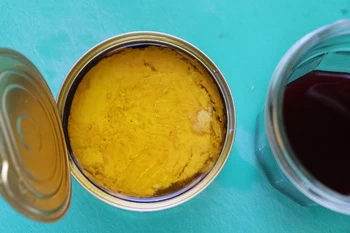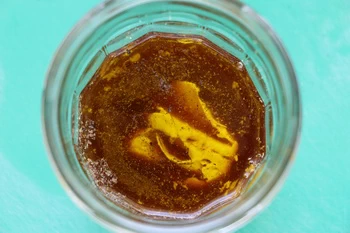Preservative oil, an asset for taste

When you prepare a dish using an ingredient that has been preserved in fat, for example a springtime mixed salad with tuna in oil or sun-dried tomatoes, you're probably going to make a french dressing (vinaigrette) next.
In that case, why not use the preserved oil from the tuna or tomatoes?
In that case, why not use the preserved oil from the tuna or tomatoes?
7,677 5/5 (14 reviews)
Keywords for this post:SauceOilTaste recoveryEconomicalFatStorageLast modified on: June 5th 2024
Preservative oil, an asset for taste
It's not easy, or rather it's not something you think about very much, but it's a shame to throw away the oil used to preserve tuna or tomatoes, because it's naturally perfumed with whatever's been preserved in it.
And this taste, these aromas, will then be transmitted to your future preparations.
To take the example of the tuna in oil and the vinaigrette sauce for the salad, you proceed as usual for your salad, but when you add the tuna you collect the oil in a bowl or small jar.
Add vinegar, mustard, salt and pepper, mix well and your tuna-flavoured dressing is ready.
Just about anything that can be preserved in oil (fish, vegetables, cheese, etc.) can be used in this way, not just in a sauce, but as a cooking fat, for example.
Grill tomatoes in a little rosemary oil with cubes of feta cheese, for example, and you'll be amazed at the results.
So far, we've only talked about oil, but this applies to virtually all preservative fats.
In the same spirit, another example: roast potatoes in a little rillettes fat, and enjoy the resulting taste, in addition to the crispness of the roasted potatoes.
To sum up: don't necessarily throw away the fat used to preserve your food - it can often be used to accompany a recipe, or in cooking.
And this taste, these aromas, will then be transmitted to your future preparations.
To take the example of the tuna in oil and the vinaigrette sauce for the salad, you proceed as usual for your salad, but when you add the tuna you collect the oil in a bowl or small jar.
Add vinegar, mustard, salt and pepper, mix well and your tuna-flavoured dressing is ready.

Just about anything that can be preserved in oil (fish, vegetables, cheese, etc.) can be used in this way, not just in a sauce, but as a cooking fat, for example.
Grill tomatoes in a little rosemary oil with cubes of feta cheese, for example, and you'll be amazed at the results.

So far, we've only talked about oil, but this applies to virtually all preservative fats.
In the same spirit, another example: roast potatoes in a little rillettes fat, and enjoy the resulting taste, in addition to the crispness of the roasted potatoes.
To sum up: don't necessarily throw away the fat used to preserve your food - it can often be used to accompany a recipe, or in cooking.
Lasts posts
Butter vs. grease
We often read in a recipe where a pastry is put into a mould that, just before pouring, the mould should be buttered or greased. But what's the difference between these 2 terms?December 1st 20259625
Getting out of the fridge early
Very often when you're cooking, you need to take food or preparations out of the fridge, to use them in the recipe in progress. There's nothing tricky about this: you just take them out of the fridge and use them, usually immediately, in the recipe. But is this really a good method?November 24th 20251,0905
Who's making the croissants?
When you look at a bakery from the outside, you naturally think that in the bakery, the bakers make the bread, and in the laboratory, the pastry chefs make the cakes. It's very often like that, with each of these professions having quite different ways of working, but sometimes there's also one...November 23th 2025986
Oven height
When we put a dish or cake in the oven, we naturally tend to put it on the middle shelf, and that's what we usually do. But in some cases, this position and height can be a little tricky, so let's find out why.October 8th 20252,6945
The importance of sieving
In recipes that use a fine powder (flour, powdered sugar, etc.), you'll often see the advice to sift before using it. To sift is to pass the powder in question through a sieve (a very fine strainer) before incorporating it into your recipe. It's often advice, but is it really useful?September 3rd 20257,5163
Other pages you may also like
The return of the "Norman hole"
You maybe know the "trou normand", this old gastronomic custom typically French which consists in taking a (small) glass of calvados, generally between the last course and the dessert? It's something that seems a bit anachronistic nowadays, having a glass of an alcohol of more than 60° in the...December 18th 202115 K4.8
Should a sausage be pricked before cooking?
If you are using sausages in a recipe, you may have already asked yourself the question: Should you prick it before cooking it, or not? You will certainly find as many opinions "you should prick" as "you should not". Let's try to untangle all this.September 29th 201848 K4.1
Balancing flavours
In the kitchen, we sometimes use ingredients that can be a little overwhelming in taste. Grilled lardons, for example, are very good, they give a great taste to a lot of recipes where they are added, but you have to be objective, they're still pretty fatty!November 7th 20208,8235
The 3 secrets of Parisian flan
A flan Parisien, or boulanger, is a simple yet delicious cake. A cream, a mixture of milk, eggs and sugar, is poured into a raw pastry base and baked in the oven until the pastry and cream are cooked. This is the simplest version of the recipe, probably the original one, but nowadays the cream...July 21th 202316 K4.7
The secret of cooking until "done"
This is a real chef's skill: being able to look at a fish fillet cooking and say, "Stop – that's enough, it's cooked". I always admire this ability to see at a glance if something is done. It is what sets the professionals apart from us mere amateurs. And it's true that how fish is cooked is...November 26th 201220 K4.4
Post a comment or question
Follow this page (as 3 people already do)
If you are interested in this page, you can "follow" it, by entering your email address here. You will then receive a notification immediately each time the page is modified or a new comment is added. Please note that you will need to confirm this following.
Note: We'll never share your e-mail address with anyone else.
Alternatively: you can subscribe to the mailing list of cooling-ez.com , you will receive a e-mail for each new recipe published on the site.









